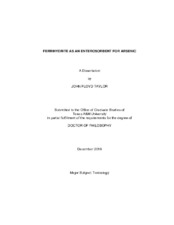| dc.contributor.advisor | Phillips, Timothy D. | |
| dc.creator | Taylor, John Floyd | |
| dc.date.accessioned | 2012-02-14T22:18:40Z | |
| dc.date.accessioned | 2012-02-16T16:14:31Z | |
| dc.date.available | 2012-02-14T22:18:40Z | |
| dc.date.available | 2012-02-16T16:14:31Z | |
| dc.date.created | 2010-12 | |
| dc.date.issued | 2012-02-14 | |
| dc.date.submitted | December 2010 | |
| dc.identifier.uri | https://hdl.handle.net/1969.1/ETD-TAMU-2010-12-8852 | |
| dc.description.abstract | Arsenic in drinking water is a problem in many developing nations such as Taiwan and Bangladesh. Currently, no oral binding agent exists for the mitigation of arsenic toxicity. The goals of this research were to 1) screen a variety of sorbents for their ability to sorb As from water and screen for potential nutrient interactions with vitamin A (VA) and riboflavin (RF) isotherms; 2) further describe the sorption of As to ferrihydrite using isothermal analysis and a simulated gastrointestinal model (GI), and by testing ferrihydrite’s ability to protect Hydra from As toxicity; 3) verify ferrihydrite’s safety and efficacy in a short term rodent model.
Ferrihydrite was found to be the most effective sorbent for both As(III) and As(V). Exchanging SWy-2 with sulfur containing organic groups increased the sorption of both As(V) and As(III) compared to the parent clay, though the total As sorbed was much less than As sorption by ferrihydrite.
Ferrihydrite and an industrially produced ferrihydrite (IPF) both sorbed As(V) and As(III) with high capacity. Both ferrihydrites also sorbed As(V) and As(III) at high capacity in the simulated GI model. Fe measured in the simulated GI tract was below tolerable daily limits for both ferrihydrite and IPF. Ferrihydrite at 0.25 percent w/w was found to protect Hydra up to 200 times the minimal effective concentration (MEC) for As(III) and over 2.5 times the MEC for As(V), while IPF at 0.25 percent w/w protected Hydra up to 200 times the MEC for As(III) and just over 2 times the MEC for As(V).
IPF was apparently safe and well tolerated by the rats in our study over a period of 2 weeks. No statistically significant differences were seen in serum biochemistry, serum Fe, serum VA, or serum vitamin E between rats fed control diet versus those fed 0.5 percent w/w IPF. Ferrihydrite was found to reduce urinary As after a single gavage of 0.5 mL of 500 ppm As(III) or As(V). These results verify in vitro findings and suggest that ferrihydrite is apparently safe and effective as an enterosorbent for As. | en |
| dc.format.mimetype | application/pdf | |
| dc.language.iso | en_US | |
| dc.subject | Arsenic | en |
| dc.subject | Enterosorption | en |
| dc.subject | ferrihydrite | en |
| dc.title | Ferrihydrite as an Enterosorbent for Arsenic | en |
| dc.type | Thesis | en |
| thesis.degree.department | Veterinary Integrative Biosciences | en |
| thesis.degree.discipline | Toxicology | en |
| thesis.degree.grantor | Texas A&M University | en |
| thesis.degree.name | Doctor of Philosophy | en |
| thesis.degree.level | Doctoral | en |
| dc.contributor.committeeMember | Hallmark, Charles T. | |
| dc.contributor.committeeMember | Porter, Weston W. | |
| dc.contributor.committeeMember | Welsh, Christabel J. | |
| dc.type.genre | thesis | en |
| dc.type.material | text | en |


